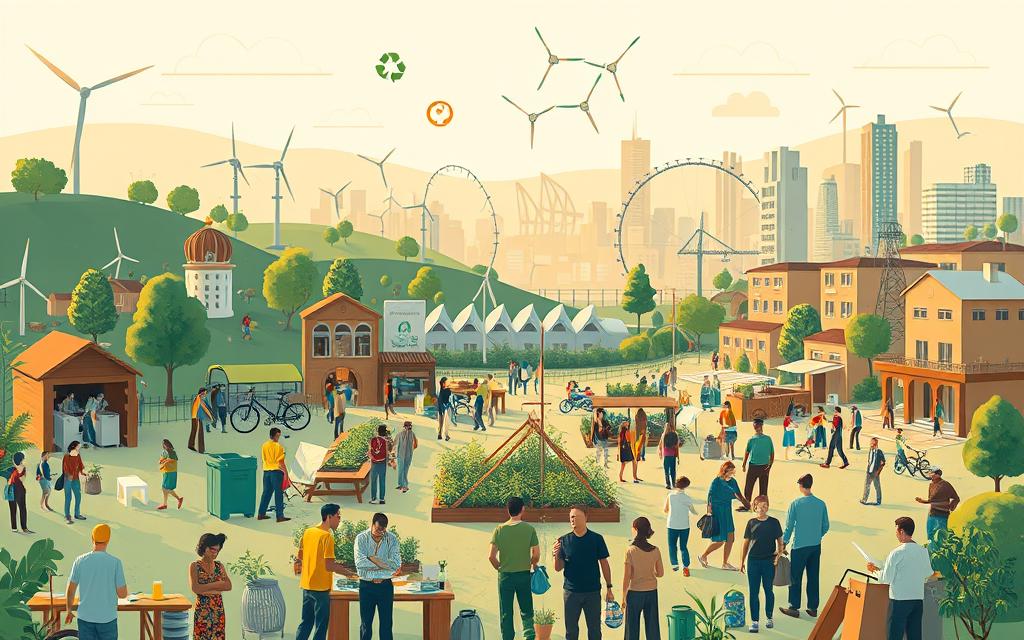Advertisement
Did you know the average American throws away about 4.4 pounds of trash daily? This shows we really need sustainable business practices and community efforts to cut down on waste.
Zero-waste communities lead the way in this fight. They push for environmental initiatives that make us share, reuse, and recycle more. By using circular economy programs, they not only lessen landfill waste but also build a sustainable culture.
These communities are living proof that working together can make a big difference. By looking at their methods and achievements, we can learn how to make our future greener.
Understanding Circular Economy Programs
For a greener future, knowing about circular economy programs is key. These efforts aim to cut down on waste and use resources wisely. This helps keep our environment healthy.
What is a Circular Economy?
A circular economy works to avoid waste and keep resources in use forever. It’s a system where materials are used for as long as they can be, then recycled or reused. This is different from the old ‘take, make, dispose’ way of doing things.

Benefits of a Circular Economy
Switching to a circular economy brings many advantages. It cuts down on waste, saves natural resources, and creates new jobs. By making products and services that can be fixed and reused, companies can grow while helping the planet.
It also means less harm to the environment, more secure resources, and a competitive edge for businesses. Plus, it can save money for both companies and customers.
Key Principles of Circular Economy Programs
These programs follow a few main rules. They aim to reduce waste and pollution, keep things in use, and help nature heal. To make this work, everyone needs to work together.
- Designing out waste and pollution
- Keeping products and materials in use through sharing, leasing, and product-as-a-service models
- Regenerating natural systems by promoting the use of renewable energy and materials
By understanding and using these rules, we can build strong circular economy programs. These programs help make our future more sustainable and strong.
The Rise of Zero-Waste Initiatives
The world is moving towards sustainability fast. Zero-waste initiatives are leading this change. They cut down waste and encourage living in a more eco-friendly way.
Historical Context of Zero-Waste Movements
The idea of zero-waste has been around for a while. It started in cultural and environmental movements. But, it really took off in the late 20th century as people became more worried about waste and the environment.
Key milestones in the zero-waste movement include early recycling programs and government waste reduction targets. These steps helped create the zero-waste plans we have today.
Popular Zero-Waste Models
There are many zero-waste models around the world. Each one has its own way of cutting down waste. The Zero Waste International Alliance helps communities follow a set of rules to become zero-waste.
- Reduce, Reuse, Recycle: This model is simple but effective. It teaches people to reduce waste, reuse items, and recycle.
- Circular Economy: This model keeps resources in use forever. It aims to reduce waste and make the most of resources.
Case Studies of Successful Programs
Many places have made big strides in reducing waste. For instance, San Francisco’s Zero Waste Program has set a high standard. It has diverted over 80% of waste through recycling and composting.
Kamikatsu, Japan is another example. It has become a zero-waste town by sorting waste carefully and encouraging recycling and composting.
These examples show that with the right effort and plans, communities can greatly reduce waste. They can work towards a greener future.
Community Participation and Engagement
Community participation is key to successful circular economy programs. It builds a culture of sustainability and teamwork. By joining your community, you help and benefit from green projects that make a big difference.
How to Get Involved in Circular Economy Programs
It’s easy to join circular economy programs. First, look for local initiatives that match your interests and skills. Many places have groups working on waste reduction, recycling, and green living.
- Join local environmental groups or clubs.
- Participate in community clean-up events.
- Attend workshops or seminars on sustainable living.
By doing these things, you help your community and work towards a greener future.
Building a Supportive Network
A supportive network is essential for community success. Work with others who share your goals. This can mean:
- Starting or joining a local cooperative.
- Working with local businesses to promote green practices.
- Hosting events to spread the word about circular economy.
Creating such a network boosts your efforts and offers a place to share ideas and resources.
Strategies for Successful Community Engagement
Effective community engagement needs smart strategies. Here are some good ones:
| Strategy | Description | Benefits |
|---|---|---|
| Education and Awareness | Run workshops and seminars to teach about circular economy benefits. | More people get involved, understand green practices better. |
| Inclusive Participation | Make sure everyone can join in circular economy efforts. | More diverse views, wider community support. |
| Feedback Mechanisms | Create ways for people to share thoughts on initiatives. | Improves things, keeps people happy. |
Using these strategies helps communities become more active and involved.
Getting involved in your community and circular economy programs is fulfilling. It helps create a better future. By participating, building a network, and using good strategies, you can really make a difference.
Local Governments and Circular Economy
Local governments are leading the way towards a sustainable future. They play a key role in promoting the circular economy. This helps in creating a better environment for businesses and the community.
Role of Government in Promoting Zero-Waste
Local governments can make a big difference by setting rules and offering incentives. For example, they can set waste reduction targets and teach people about recycling. This encourages everyone to join in.
Incentives for Zero-Waste Practices:
- Tax breaks for businesses adopting zero-waste policies
- Grants for community projects focused on waste reduction
- Recognition programs for individuals and businesses making significant contributions
Policies Supporting Circular Economy Initiatives
Good policies are essential for the circular economy to thrive. Local governments can create rules that promote recycling and reduce waste. This includes making manufacturers responsible for the waste their products cause.
“The circular economy is not just about waste management; it’s about creating a new economic model that is restorative and regenerative by design.” – Ellen MacArthur
Funding Opportunities for Local Programs
Local governments can find funding for circular economy projects. They can get grants, private investments, and work with the private sector.
| Funding Source | Description | Benefits |
|---|---|---|
| Government Grants | Funds allocated by government agencies for specific projects | Supports innovative projects, encourages community engagement |
| Private Investments | Investments from private entities in circular economy projects | Brings in capital, promotes sustainable business practices |
| Public-Private Partnerships | Collaborations between government and private sector | Combines resources, expertise, and risk; fosters innovation |
By using these funding sources, local governments can grow circular economy projects. This helps make their communities more sustainable for the future.
Innovative Circular Economy Solutions
Innovative circular economy solutions are changing how we manage waste and focus on sustainability. By using new technologies and practices, communities can greatly lessen their impact on the environment.
Upcycling as a Sustainable Practice
Upcycling, or making new products from old materials, is becoming more popular. It cuts down on waste and encourages creativity. For example, TerraCycle is leading the way by making goods from non-recyclable waste.
As upcycling grows, it helps change how we see waste. Seeing waste as a valuable resource is key for circular economy success.
Sharing Economy Platforms
Sharing economy platforms are another great solution for sustainability. They help use what we already have more efficiently. Sites like Airbnb and Uber show how sharing can cut down on waste and emissions.
“The sharing economy has the potential to redefine ownership and consumption patterns, promoting a more efficient use of resources.” –
These platforms offer economic benefits and help the environment. They reduce waste and the need for new resources.
Composting and Food Waste Reduction
Composting and cutting down on food waste are vital for a circular economy. Composting turns organic waste into something good for the soil. Communities are starting composting programs to handle food waste well.
- Implementing curbside composting collection
- Educating residents on what can be composted
- Creating community composting initiatives
By composting and reducing food waste, communities can lessen landfill waste and emissions.
Educational Resources for Zero-Waste Living
Education is key in the zero-waste movement. It gives people the knowledge to make eco-friendly choices. With the right resources, communities can grow a culture of sustainability and cut down on waste.
Workshops and Events in Your Community
Local workshops and events are vital for teaching zero-waste practices. They often include hands-on activities like composting and DIY recycling. This lets people learn by doing.
A community might host a zero-waste workshop. Here, people learn about minimal packaging and waste reduction. These events not only teach but also bring people together.
Online Resources and Guides
Online, there’s a lot of info on living zero-waste. Websites and blogs share guides and tutorials on various topics. This includes how to reduce household waste and choose sustainable fashion.
Online platforms also help people share ideas and experiences. This creates a global community dedicated to zero-waste living. A sustainability expert noted,
“The internet has been a game-changer in spreading the word on sustainable practices. It makes it easier for people to live zero-waste.”
Collaborations with Schools and Universities
Schools and universities play a big role in teaching zero-waste practices. By adding sustainability to their curricula, they help students develop eco-friendly habits early on.
Working together, schools and zero-waste groups can create new projects and research. These partnerships improve education and help advance zero-waste efforts.
Some effective strategies for these collaborations include:
- Creating curriculum modules on sustainability
- Starting zero-waste initiatives on campus
- Doing research on sustainable practices and waste reduction
Businesses Supporting Circular Economy Programs
Businesses are leading the way towards a zero-waste economy. They are innovating and focusing on sustainability through circular economy initiatives. This shift is crucial as the world faces waste management and environmental issues. Companies are now adopting practices that cut down their environmental impact and help create a better future.
Local Businesses Embracing Zero-Waste
Local businesses play a key role in promoting zero-waste in their communities. By using circular economy models, they can greatly reduce waste and boost resource use. This also helps improve their reputation.
For example, local shops can start recycling programs, cut down on packaging, and encourage product reuse.
Examples of local businesses going zero-waste include:
- Starting composting for food waste
- Switching to biodegradable or recyclable packaging
- Launching product take-back or product-as-a-service models
Benefits for Companies in Going Circular
Companies gain a lot by adopting circular economy practices. They save money, improve their image, and meet stricter environmental laws. By cutting down waste and using resources better, they can also become more competitive.
Going circular also encourages innovation. It leads to new business models, products, and services that meet changing consumer needs.
Partnerships Between Businesses and Communities
Businesses and communities working together is key for circular economy success. By teaming up with local groups, companies can understand community needs better. This helps them develop specific initiatives and build a sustainable culture.
These partnerships can be in many forms, like waste reduction programs, education projects, or joint sustainability efforts. Through these collaborations, businesses can help their communities and improve their own sustainability and social responsibility.
Overcoming Challenges in Circular Economy Implementation
It’s key to beat the challenges in circular economy implementation to reach sustainability goals. Communities trying to go circular face big hurdles that slow them down.
Common Barriers to Zero-Waste Programs
One big challenge is the lack of infrastructure and resources for zero-waste. This includes not enough recycling facilities, poor waste collection, and few composting options.
Another big hurdle is not enough knowledge and education about zero-waste living. Without understanding and involvement, it’s hard to get everyone on board with circular economy programs.
Solutions to Overcome Challenges
To tackle these challenges, communities can use waste reduction strategies. For example, investing in recycling and composting facilities can cut down waste a lot. Also, educational workshops and outreach can help people learn and join zero-waste efforts.
Working together is also key. Local governments, businesses, and community groups need to team up. This way, they can create and run resource efficiency programs that help everyone.
Inspirational Stories of Success
Many communities have beaten the odds and started successful circular economy programs. Cities like San Francisco and Vancouver have set up great recycling and composting systems. This has led to a big drop in waste and better sustainability.
These inspirational stories show that with hard work, teamwork, and smart plans, communities can succeed in a circular economy.
Measuring Success in Circular Economy Programs
To keep circular economy programs going, we need to measure their success well. We look at different parts of these programs to see how well they work. This helps us find ways to get even better.
Key Metrics for Evaluation
There are key metrics to check if circular economy programs are doing well. These include:
- Reduction in Waste: We track how much less waste is made by communities or businesses.
- Recycling Rates: We watch how much of materials are recycled.
- Carbon Footprint Reduction: We see how much less greenhouse gas emissions there are.
- Cost Savings: We look at the money saved by using circular economy practices.
By watching these metrics, we can see how well our circular economy efforts are doing.
Tools for Tracking Progress
There are many tools to help us see how circular economy programs are doing. Some of these tools are:
| Tool | Description | Benefits |
|---|---|---|
| Material Flow Analysis (MFA) | A way to check how materials move in a system. | Helps us find ways to use resources better. |
| Life Cycle Assessment (LCA) | A way to look at the environmental effects of products from start to end. | Shows how sustainable products are. |
| Circular Economy Indicators | Tools to measure how circular an economy is. | Helps compare how well different places are doing. |
How to Communicate Success Stories
Telling the success of circular economy programs is key to getting more support. We can do this by:
- Storytelling: Sharing stories of how circular economy efforts have made a difference.
- Data Visualization: Using pictures and charts to show what we’ve achieved.
- Stakeholder Engagement: Working with everyone involved to make sure their voices are heard.
By using these methods, we can show the value of our circular economy programs well.
Future Trends in Circular Economy Initiatives
The future of circular economy initiatives is bright. New trends are set to change how we manage waste and focus on sustainability.
Emerging Technologies
New green technologies are key to a zero-waste future. Things like biodegradable materials and better recycling tech are being made. They aim to cut down waste and make circular economy programs work better.
Eco-Friendly Initiatives
More communities are going green, adopting zero-waste models. They’re pushing for sustainable living. This trend is growing, thanks to more people wanting eco-friendly products and services.
Consumer Awareness
Consumer awareness is vital for circular economy success. As people learn about sustainable living, they choose eco-friendly options. This supports waste reduction and green initiatives.



